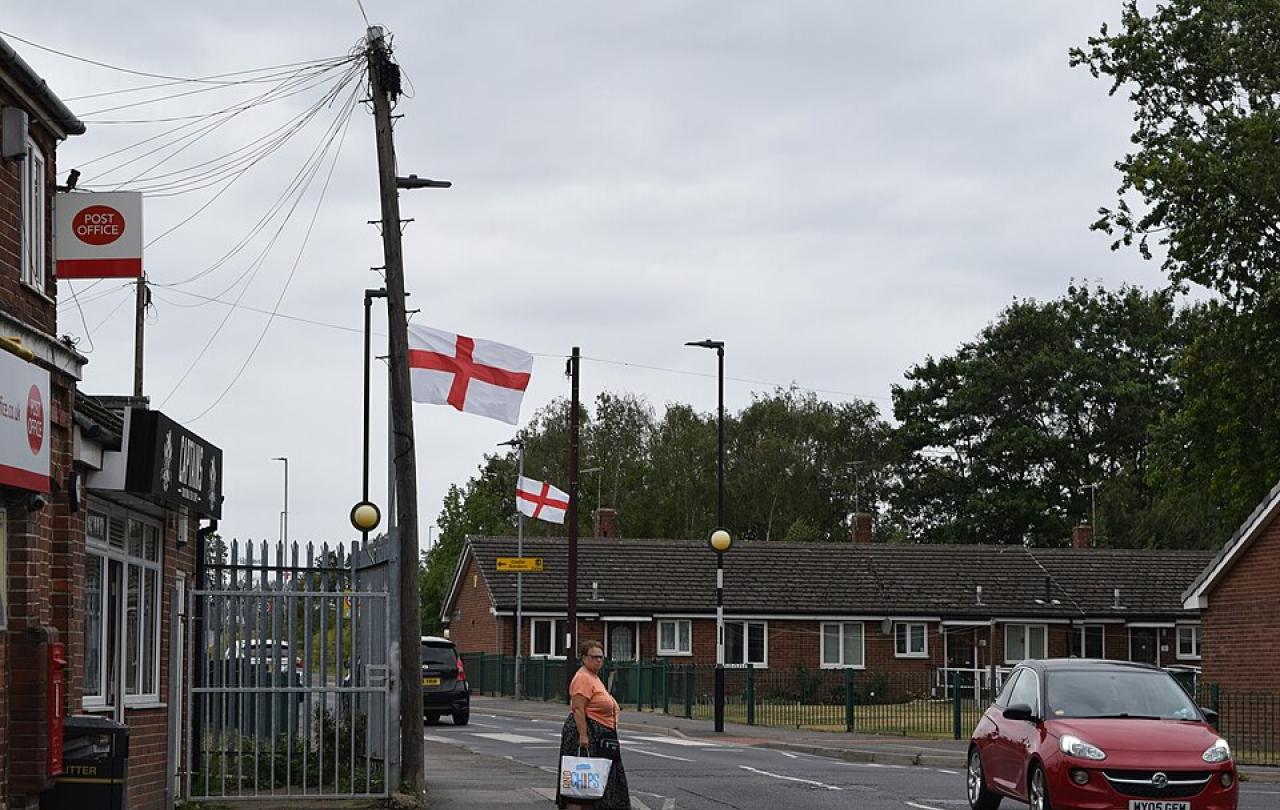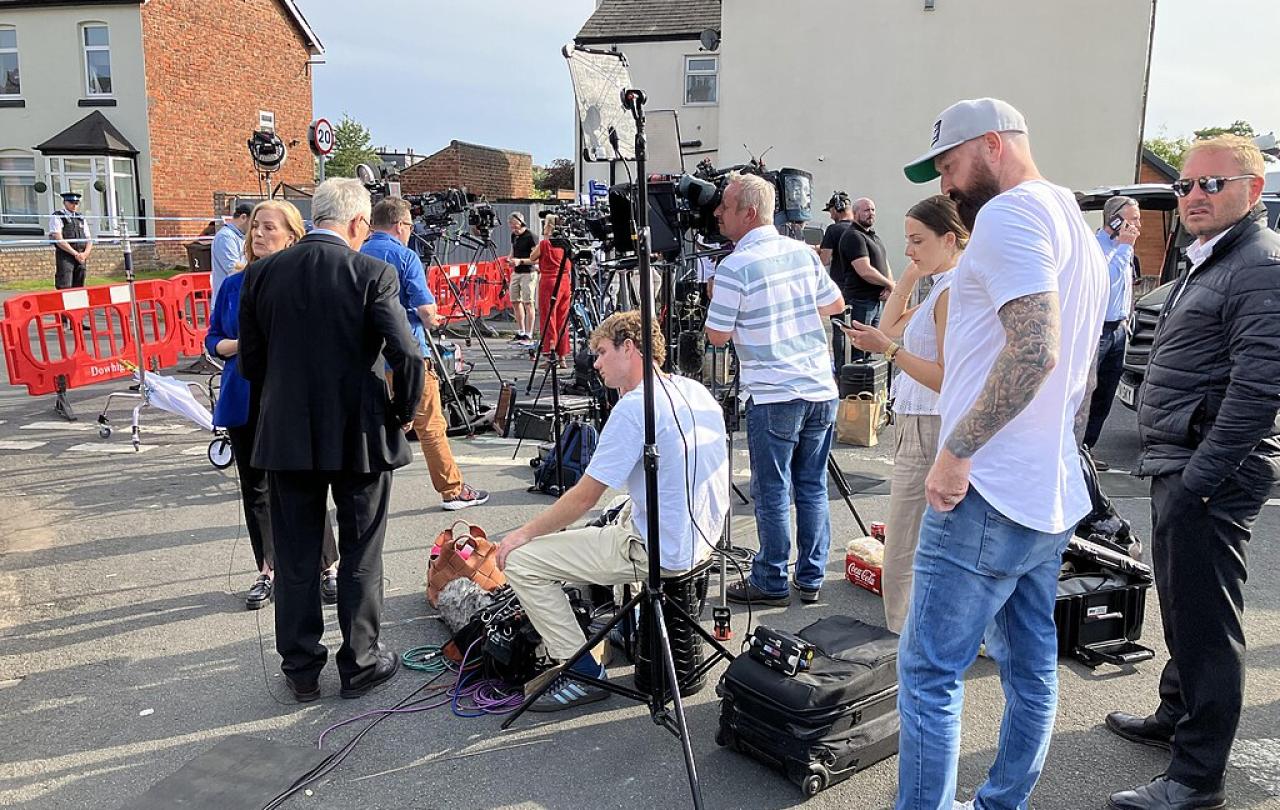
I was in the local pub the other week and overheard a conversation at the bar prompted by Operation Raise the Colours, the campaign group that advocates for the Union flag and the St George’s Cross to be hung in public places.
Striking was the opinion of one man who repeatedly stated that he was not a fascist or a racist but supported anti-immigration policies and the deportation of migrants and asylum seekers for the sake of his young granddaughter. It was a lack of hope for her future, he kept asserting, that meant politicians needed to take a more aggressive stance against people arriving in this country hoping to live here. He therefore supported the raising of the St George’s Cross as a sign of the national identity he hoped his granddaughter would grow up to experience.
In the last hundred years the St George’s Cross has been a sign of Empire, military might, hooliganism, English Nationalism, xenophobia, fascism, and other violent and oppressive worldviews. It meant for many who did not want to be associated with these things that they could never raise or recognise the flag at all.
But there has also been some reclamation of our national symbols. Cool Britannia and Britpop under New Labour saw a new pride in the Union flag; England’s football team under Gareth Southgate and the ‘proper’ English Lionesses were successful, articulate, and diverse under the Cross of St George. It's why even now it’s hard to discern whether someone with a Cross of St George stuck to their house endorses Tommy Robinson, or whether they’re showing their support for the England women’s rugby team, who are swept all opposition before them whilst cavorting in pink cowboy hats and redefining all kinds of feminine stereotypes.
These myriad options for painting identities onto national colours seems particularly clear in Leicester, where I live and work. We live in the outer suburbs, meaning two miles in one direction, humans are outnumbered by sheep, and two miles in the other is the incredibly diverse edge of the city.
Leicester famously has the most diverse street in the UK, Narborough Road, where people from many nations live and work, generally in relative harmony. Skills are shared: help with government forms for those without good English are informally bartered for meals, haircuts, or produce. Christians, Jews, Muslims, Sikhs, Hindus and many other faiths worship within close proximity. It seems a place symbolic of one kind of England: diverse, tolerant, enriching the lives of one another by the sharing of culture and skills.
It’s easy to point to recent riots between Hindu and Muslim populations in the north of the city as proof of the opposite. Nevertheless, having worked in a diverse city centre church and visited schools and hospitals where many cultures and faiths study and work together, there are large pockets of the city that do generously manage to embody this vision. Faith leaders are overwhelmingly committed to mutual tolerance and respect.
I know many people in the county also wish for this version of England, but it has been striking to see how many villages surrounding the city have joined in with Operation Raise the Colours. Its anti-immigration message provides a clear-cut visual contrast. In the city there are no St George’s Crosses but innumerable signs of inter-culturalism brought by immigrants, asylum seekers and refugees. It is the first city in the UK where being white British does not put you in the majority. In the county, these flags seem to state that these signs are not welcome. That to ‘Unite the Nation’ is to expel those different to us. That the only culture available is the one they want to equivocate with the St George: white, British, suspicious of outsiders.
Both of these contexts seem to be fully fleshed out alternatives for the future of England. Who do we want to be? Tolerant, inter-cultural, diverse? Or exclusive, suspicious, nativist? The guy in the pub was staking his hope for the future on one of these alternatives, and I’m sure he’s not unique. There will be others who are fully devoted to the opposite: a diverse and welcoming state of which Leicester appears an imperfect harbinger.
It’s important to note that a fair reading of the Bible cannot help to highlight the theme of welcoming foreigners, perhaps particularly those who are not able to contribute financially. The Israelite faith of the Old Testament specifically commands farmers to leave a border of crop unharvested for such struggling migrants.
One of the most beloved stories of the Jewish scriptures is that of Ruth, an Edomite woman who comes destitute to Israel and finds provision in the righteous life of Boaz, who has left such a border of crop for her to glean. Eventually they marry, and their offspring is blessed by God: including King David and Jesus Christ. I do believe that welcoming foreigners, and particularly those who have been affected by poverty or war is just. Any form of Christianity which puts nation before those different to us or those who suffer is a false one.
But, just as I believe that man in the pub is wrong for putting his hope in the tightening of borders, anybody who puts their hope in any philosophy or system a flag can represent is mistaken. Liberal policies towards immigration and open hearts towards those who must seek asylum or refuge will always fail and fade. Neither England represented by the city and county of Leicester can or will last a millennia, let alone an eternity. Neither can guarantee a better future for our descendants.
Jesus spoke of a Kingdom without flags, without an army, and without borders. One in which all tribes and tongues will be welcomed as the foreigners we are to the Holy God. One which is already recreating the Earth to be a place without death, enmity, and suffering and one day will bring this work to fulfilment. This Kingdom of God is the only political entity in which hope can be securely placed because it keeps its promises and never passes away. Our political parties, national identities, and nation states may be more or less like the Kingdom of God but they are never secure foundations for our future.
If I were braver, I might have broached this reality with the man at the bar. I might have suggested he makes an error in placing hope for the future generations of his family in a particular understanding of the national flag. I could have invited him to see the truer potential for hope in a Kingdom which is not directly seen but nevertheless is more real and secure, and discussed with him about what that means for our temporal reality. And challenged him to see past the flag to a Kingdom which will provide for his granddaughter without measure.
Support Seen & Unseen with a gift
Since Spring 2023, our readers have enjoyed over 1,500 articles. All for free.
This is made possible through the generosity of our amazing community of supporters.
If you enjoy Seen & Unseen, would you consider making a gift towards our work?
Do so by joining Behind The Seen. Alongside other benefits, you’ll receive an extra fortnightly email from me sharing my reading and reflections on the ideas that are shaping our times.
Graham Tomlin
Editor-in-Chief





